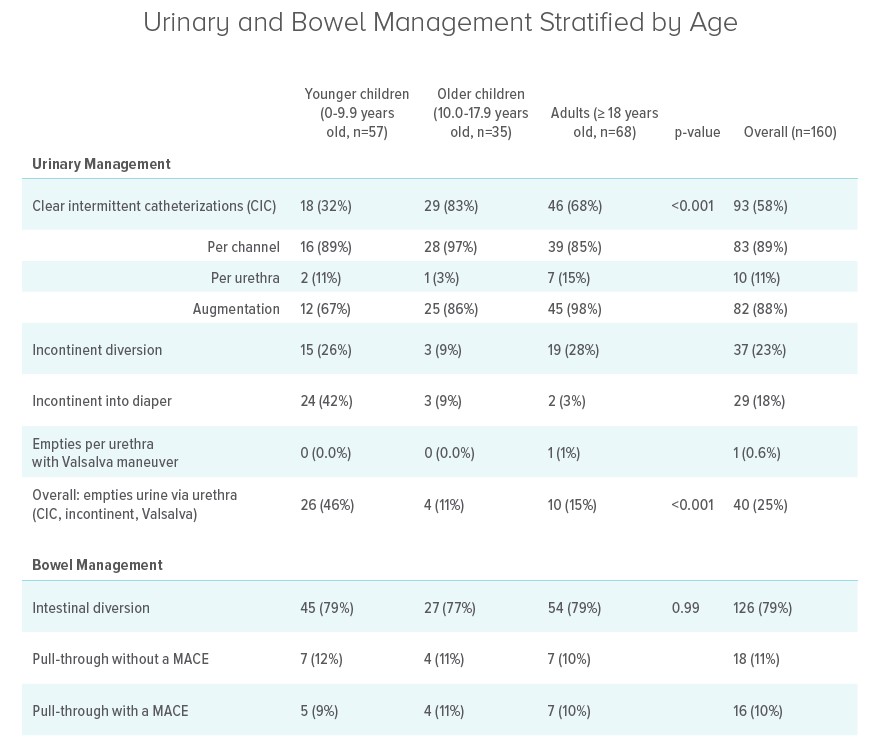Urinary and Bowel Management in Cloacal Exstrophy
Research By: Andrew Strine, MD, MPH
Post Date: October 7, 2022 | Publish Date: Oct. 7, 2022
Urology | Top Scientific Achievement


When children are born with cloacal exstrophy (CE), a rare disorder that causes significant abnormalities of the genitourinary and gastrointestinal systems, treatment often requires numerous surgical procedures and ongoing management. Unfortunately, even with skillful reconstructive surgery, urinary and fecal continence remains an elusive goal.
This study evaluated the long-term surgical urinary and bowel management outcomes in CE patients across five institutions, with a focus on prevalence and differences in management based on institution and patient demographics. It was conducted by Andrew Strine, MD, MPH, pediatric urologist and co-director of the Comprehensive Fertility Care and Preservation Program at Cincinnati Children’s, along with colleagues at the other institutions.
Researchers observed that none of the 160 participants voided by urethra, which suggests that normal urination may be very rare in this patient population. While 42% of children were incontinent in diapers, 94% of older children and adults required incontinent diversion or clean intermittent catheterization to manage their bladders.
On average, CE patients with urinary incontinence needed two surgical procedures. Nearly 80% of patients needed intestinal diversion, while bowel diversion varied significantly between institutions.
“The findings bring into question what functional goals of reconstructive surgery are achievable,” the co-authors say. “Reconstructive urologists should set realistic expectations to minimize harm and to rethink reconstructive goals in the CE population, incorporating patient and family values in the decision-making process.”
When CE was first described, the primary clinical focus was on survival. Thanks to advancements in management, neonatal survival now approaches 100%. With this, there has been a more recent shift in focus on quality of life for patients with CE.
More 2023 Research Highlights
Chosen by the Division of Urology
Kennedy U, Daugherty M, Frischer J, et al. Reoperative Anorectal Procedures in Patients with Anorectal Malformations – Is Bladder Function Affected?. J Pediatr Surg. 2023;58(10):1910-1915. doi:10.1016/j.jpedsurg.2023.04.015
Trinidad S, Garrison A, Encisco EM, et al. Long-Term Male Sexual Function and Fecal Incontinence Outcomes for Adult Patients with Hirschsprung Disease or Anorectal Malformation. J Pediatr Surg. 2023;58(8):1573-1577. doi:10.1016/j.jpedsurg.2023.04.006
Joshi RS, Eftekharzadeh S, Shukla AR, et al. Kidney function outcomes in patients after complete primary repair of bladder exstrophy and penopubic epispadias: Results from the international bladder exstrophy consortium. J Pediatr Urol. 2023;19(1):34.e1-34.e9. doi:10.1016/j.jpurol.2022.04.018
DeFoor W, Nehus E, Schulte M, et al. Enteral nutrition and the risk of nephrolithiasis in complex pediatric patients. J Pediatr Urol. 2022;18(6):743.e1-743.e6. doi:10.1016/j.jpurol.2022.06.003
Strine, A.C., VanderBrink, B.A. Enhanced Recovery After Surgery (ERAS) for Lower Urinary Tract Reconstruction in Children. Curr Treat Options Peds 8, 174–191 (2022). https://doi.org/10.1007/s40746-022-00241-2
View more discoveries from 50 research divisions and areas
Return to the 2023 Research Annual Report main features
| Original title: | Urinary and bowel management in cloacal exstrophy: A long-term multi-institutional cross-sectional study |
| Published in: | Journal of Pediatric Urology |
| Publish date: | Oct. 7, 2022 |








